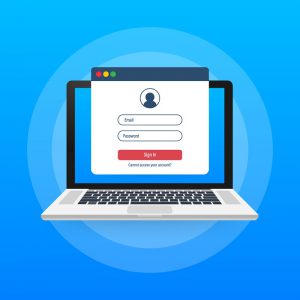Thirty years ago, the Americans with Disabilities Act (ADA) made discrimination against people with disabilities illegal, and led to the addition of state accessibility laws. The ADA covers state and local government entities, all employers, and places of public accommodations, and individual state accessibility laws may have additional regulations Since then, businesses have updated both their physical and digital landscapes to accommodate a variety of different needs to comply with national and state accessibility laws. Curb cuts with raised bumps are now commonplace, along with beeping “walk” signs, automatic doors, and accessible parking spaces. Employers offer accommodations such as elevators, accessible workspaces, magnification software, and digital forms.
 With the Coronavirus pandemic forcing many businesses to work and offer products and services to customers online, companies are now having to examine their digital accessibility accommodations more closely. Their ramps, wide aisles, and accessible parking spaces no longer guarantee everyone can easily reach them. If you haven’t consciously made your company’s digital environment accessible to all clients and employees you are denying people with disabilities access to your organization’s digital information. That is discrimination.
With the Coronavirus pandemic forcing many businesses to work and offer products and services to customers online, companies are now having to examine their digital accessibility accommodations more closely. Their ramps, wide aisles, and accessible parking spaces no longer guarantee everyone can easily reach them. If you haven’t consciously made your company’s digital environment accessible to all clients and employees you are denying people with disabilities access to your organization’s digital information. That is discrimination.
What does digital discrimination look like?
When tackling digital accessibility, companies often start with the most commonly accessed elements and quickest wins. This usually means correcting untagged web pages, removing flashing images, or changing the color on poorly contrasted fonts. Companies may leave PDFs on the backburner. It’s easy to overlook PDF files of meeting minutes or archived user guides from years ago stored on your website. However, if someone needs any of those and cannot get to them, it’s a struggle on their part and a legal liability on yours.
While PDFs are easy and convenient to save and share, they aren’t always accessible to everyone. People who use assistive technology to access the internet often find that PDFs are not digitally tagged for their equipment. Without proper digital tagging, PDFs look like a sea of disorganized words without regard for their relation to one another. Or they can appear utterly blank and simply read by assistive technology as, “this document needs to be tagged.” A table or page with two columns would be read the same as a giant paragraph- top to bottom and left to right, straight across the columns. Images (including important elements like diagrams or graphs) that do not have alternative text will provide no information except the word “image.”
What does compliance with federal and state accessibility laws look like for PDFs?
Currently, the Department of Justice has set no clear legal standards for exactly what an accessible website or PDF document looks like, or even whether the ADA applies to websites. But many circuit courts have ruled that websites and their contents are places of public accommodation. Other courts consider websites to be services of places of public accommodation, which also fall under the ADA. Many courts use WCAG standards developed by the W3C to evaluate whether or not a website or document is accessible.
While the ADA is nationally recognized and applicable, individual states may have additional laws governing accessibility, and when a company fails to accommodate everyone they can face litigation on a local, state, and federal level. Plaintiffs can’t recover damages on a federal level from an ADA violation. Plaintiffs can, however, recover court costs and legal fees, and state or local courts may award damages as well.
Let’s look at a few examples in different states:
Eleanor from New York
Eleanor works for a state government agency in New York and is blind. These past few months, the agency required all employees to work from home. While Eleanor enjoyed eliminating her commute, she struggled to set up an office at home that’s as functional as her normal workspace. At her physical workspace at the office, she has a desktop computer set up with JAWS and a Braille display. Using these, she can access the agency’s internal server to retrieve the documents she needs to do her job. Working from home, she managed to set up the new, work-issued laptop with JAWS and a Braille display, but couldn’t access the server. Before the shutdown, employees could only connect to the server from computers on the office’s network. The agency’s IT team created a new secure portal by which employees can access agency documents remotely. The quickly-assembled new portal is not accessible, even though the PDFs it contains are.
Eleanor can’t do her job without being able to access the server. This is discrimination. By failing to make the portal accessible, they are denying Eleanor the ability to work independently. Workplace discrimination is illegal according to NY state accessibility law, which follows the same guidelines as the Rehabilitation Act’s Section 508, requiring all Information and Communication Technology to be accessible.
Kevin in California (Based on an actual class-action lawsuit)
Kevin is a blind man who lives in California. His favorite hobbies are hiking and camping with his family. Meteorologists predicted clear skies for the weekend, so Kevin wanted to plan a camping trip since they’d been stuck inside for so long. The campsite reservation page for California Department of Parks and Recreation had recently been redesigned, and Kevin was excited that he would finally be able to access it with his assistive technology. However, he was very disappointed to learn that the website still was inaccessible to his screen reader, and he was unable to access the PDF brochures that showed him where the campsites were. He had to call a friend to make the reservation for him.
This is a violation of several different regulations. The California Department of Parks and Recreation is a state-run agency and therefore must comply with Section 508 of the Rehabilitation Act, California Government Code Section 1135, and AB 434, all of which require information technology created or used by the state to be fully accessible. AB 434 specifies that digital resources must meet WCAG 2.0 standards. Further, the Unruh Act prohibits any discrimination against any protected class of people, such as those with disabilities. Organizations that violate the Unruh Act are subject to a $4,000 minimum fine, on top of any court costs and legal fees for every violation.
Sylvia in Florida
Sylvia is a blind Florida resident who loves to shop. Her favorite women’s clothing retailer is also located in Florida. When the stores shut down to help decrease the spread of the Coronavirus, Sylvia’s favorite store didn’t have the manpower to update each new product on their eCommerce site. They simply uploaded a PDF brochure of their spring collection and asked customers to call to place their orders. While this was less convenient than simply clicking “add to cart,” Sylvia understood the company’s new ordering arrangement. She pulled up the PDF file but was disappointed that the store had not tagged or described the images. Her screen reader simply read “image” when she selected each part of the new catalog.
Florida is in the 11th Circuit Court, which has held in the past that websites are covered by the ADA if they are nexus to a place of public accommodation, like Sylvia’s favorite store. They have excluded a particular group of people- those with visual disabilities who use assistive technology- and are therefore discriminating. Florida state accessibility law prohibits discrimination by places of public accommodation. The store could face a fine of up to $10,000 if Sylvia decided to file a lawsuit against them. They would also have to pay Sylvia’s court costs and legal fees.
Accessibility is more than just curb cuts and elevators
Excluding any protected group by any means, including by the use of inaccessible PDF documents, is discriminatory and illegal. Eleanor faced employment discrimination because she was unable to do her job when her employer failed to offer an accessible portal for PDFs. Kevin faced discrimination by a state government entity when the department’s new website was inaccessible. Sylvia faced discrimination when the ordering process for her favorite store became inaccessible. Most companies have taken steps to make their physical locations accessible to all employees and clients with disabilities. They must now put just as much time and effort into making their digital environments accessible as well, including PDFs.
The post State Accessibility Laws Don’t Stop At Curb Cuts appeared first on Equidox.




